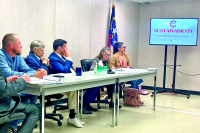Making it matter: the new paradigm behind Haywood’s tourism grants
 There was something markedly absent from the nearly $300,000 in tourism grants awarded by the Haywood County Tourism Development Authority this year: contention.
There was something markedly absent from the nearly $300,000 in tourism grants awarded by the Haywood County Tourism Development Authority this year: contention.
Doling out mini-grants for tourism projects used to be the most dreaded and criticized role of the Haywood County tourism board. A tug-of-war often ensued as festival organizers and tourism players went to the mat for their perceived fair share of the tourism tax dollars.
Should niche ad campaigns cater to motorcyclists or golfers or skiers? How should visitor center subsidies be divvied up between Waynesville, Maggie and Canton? Should the big-daddy festivals with a proven tourist draw always land the biggest grants, or should they move over and make way for newcomers on the festival scene?
The tourism board has tried to ditch the drama and politics from the grant process over the past several years. And it seems like it has finally worked.
“This is actually a feel-good story because we are moving in a different direction than the past when you have seen a lot of negativity,” said Mike Eveland, a tourism board member from Maggie Valley. “The people on the board right now have also evolved and watched others blaze the trail. They’ve been able to see the trials and tribulations.”
When the Haywood tourism board voted on this year’s round of tourism mini-grants in the spring, it took all of two minutes. It was a unanimous vote without a peep of debate.
Related Items
The new paradigm is largely due to key changes in the application and vetting process to move beyond the strife of the past.
“I think people who are applying for grants understand how it works now,” Eveland said. “There was frustration before. They wanted to know ‘Why are you giving this person money?’ and ‘Why aren’t you doing this?’ or ‘Why aren’t you doing that?’ I think now people are educated on what the system is.”
Devil in the details
Lynn Collins, director of the Haywood County Tourism Development Authority, was quick to point out that the mini-grants got plenty of vetting, despite the board’s final vote on the grants going off without a hitch.
For starters, anyone who wants to apply for a tourism grant has to attend a mandatory workshop that covers the criteria for grants. Applicants have to detail how the grant will be used, and more importantly, justify and document how their event or project will translate into more tourists or longer stays.
The more arduous process has resulted in self-selection: those who can’t prove a direct tourism connection simply don’t bother to apply anymore, realizing up front that their event or project won’t pass muster.
There’s extensive paperwork to be filled out for the application, and once the event’s over, the work still isn’t done. The tourism agency wants a follow-up report on the outcome — known as the economic impact form.
And that means grabbing a clipboard and actually talking to a sample of people at the festival.
“You have to ask them if they are from out of town, are they staying overnight, how many days are they staying, are they shopping and eating, how many are in their party,” Collins said. “We need to know if you truly are generating business. We have to make sure it adheres to the guidelines of what the dollars can be spent for.”
Forest for the trees
Despite its penchant for evidence that a mini-grant is worth its mettle, the Haywood tourism board is willing to think outside the box.
More than 65 grants were given out this year, and they run the gamut: tents for the Canton Labor Day festival, off-duty police to block traffic along the bike route of the Blue Ridge Breakaway and money to pay live bands at Shining Rock River Fest at Camp Hope.
But they aren’t all about festivals. Some simply contribute to the sense of place and general tourist appeal.
• A grant was awarded to volunteers with the Elk Bugle Corp in Maggie Valley, who serve as roving docents to engage with elk watchers in the Great Smoky Mountains National Park. Elk are a tourist draw, so enhancing the elk-watching experience is seen as worthwhile, albeit non-traditional.
• The same goes for grants to support the live music series put on by the Classic Wineseller and The Strand at 38 Main — two nightlife venues in downtown Waynesville.
“Entertainment is a big part of what people want and it is part of the experience,” Collins said.
• Maggie Valley uses tourism grant money to pay a costumed Miss Maggie character to walk up and down the sidewalks in town, waving to passing cars — sending a subconscious message to visitors that Maggie is a welcoming place to visit.
• Another not-so-typical grant will fund do-it-yourself bike fix-it stations, catering to the growing segment of cycling tourism.
The fix-it stations alone won’t convince cyclists to come here, but it’s part of a long-range play to establish Haywood as a cycling destination.
“It is a signal that you are a bicycle-friendly community, and it is a new market that we can capitalize on,” said Collins. “We have tremendous potential in Haywood County for cycling tourism.”
• Maggie also got $5,000 to install an electric vehicle charging station, which is a must for visitors traveling in electric cars.
• A greenway project along Jonathan Creek in Maggie Valley got an $11,000 grant this year, which in and of itself probably won’t make or break someone’s decision to come. But greenways are a sought-after amenity that contributes to the overall package of a destination.
“We are beginning to see people ask about greenway options at the visitor center,” Collins said.
• Lake Junaluska Conference Center even got money for restrooms to serve executives during its biggest conference of the year, one that rakes in 4,000 overnight visitors to the county for an average of four nights each. Inadequate restrooms for conference leaders was an unresolved issue that could have jeopardized the whole conference coming here — and thus clearly a good return on investment.
• One new grant this year is $8,000 to subsidize the salary of an event coordinator for the Haywood County Chamber of Commerce, in recognition of the heavy lifting the chamber does for several signature festivals during the year.
Climbing the ladder
Another change in recent years that’s led to smoother sailing is how the mini-grants are vetted.
These days, the full tourism board doesn’t get into the weeds of each grant. Instead, the tourism board is merely the third and final stop in a months-long process — with front-loaded vetting being done by a suite of committees.
The first round of vetting is at the community level.
A Maggie committee vets all the applications from the Maggie area, a Waynesville committee vets applications from the Waynesville area, and so on.
The committees hash out the merits of the projects amongst themselves. Each has its own pot of money to work with, and divvies it up among the projects in their own backyard.
“They talk about it and discuss it and spend several hours on it,” Collins said. “They are really being good stewards of the money.”
The next stop is the tourism board’s finance committee, which reviews the list from the community-based committees and makes its own recommendations, which are fed up the chain to the full tourism board.
The tourism board isn’t completely hands-off. But rather than second-guess the recommendations coming up the ladder, the Haywood tourism board has been attaching some strings to the funding — think of it as constructive criticism.
Some festivals that got funding this year saw additional criteria for how they could use it. Festivals can’t use their mini-grants for brochures or posters, for example, but can only use it for advertising in media outlets more than two hours away.
“What kinds of ways can you advertise that will give you more bang for your buck?” Eveland said.
Last year, the tourism board would give money to the Folkmoot international dance festival only if it improved its website.
“We have the resources and the tools and the knowledge to be able to share with these folks and perhaps make them think about some things they haven’t thought about,” Collins said. “Everybody on our board has some type of tourism-related business.”
That means they may understand what caters to tourists better than a group putting on a dog show might if left to its own devices.
For example, Bike Haywood got a tourism grant to install bike fix-it stations around the county, but the grant came with the added stipulation that the GPS coordinates of each fix-it station be included in cycling marketing materials.
A success story
While the tourism authority handles branding and marketing for Haywood County overall, the mini-grants fill in the gaps by marketing specific festivals, attractions or individual parts of the county.
Lately, Maggie has pooled a large portion of its mini-grant allotment — about $67,000 — on co-op advertising, a trend Collins lauds.
“Instead of advertising each organization or every festival and event, this is umbrella advertising. They are able to talk about Maggie Valley as a destination,” Collins said.
Rather than the Maggie Valley Motel Association running an ad to stay in Maggie, and a festival running a separate ad promoting an event, they are combining their grant dollars to run a bigger ad with more reach that accomplishes both goals, Collins said.
“Before, the ads were for festivals and events that happened to be in Maggie. Now they are also including what there is to do in Maggie,” Collins said.
She attributes this strategy to the bump in tourism in Maggie over the past year.
“Maggie numbers are up. I think a lot of it has had to do with the co-op marketing program,” Collins said.
Advice from next door: how to award grants without getting in a fight
While it’s old hat in Haywood, neighboring Jackson County is largely new at the whole tourism grant business. The countywide tourism board has only been in existence a couple of years. So it’s still settling into its role as one that controls the purse strings.
Jackson’s tourism board used a scatter-gun approach to doling out grants this year: if you applied, you got money.
That’s a luxury Haywood’s tourism board doesn’t have, simply due to the sheer volume. Jackson got less than a dozen tourism funding requests, compared to more than 75 in Haywood.
Haywood County brings in about $1 million annually from the tourist tax tacked on to the bill of overnight accommodations. About $300,000 went to mini-grants this year, ranging from $1,000 to $4,000 on average.
Here’s a few “been there done that” lessons Haywood’s tourism board has to offer Jackson as they figure out how to vet and measure which projects should get money.
Tip #1: Make them do their homework
Anyone vying for a piece of the pie in Haywood must attend an annual workshop on how to properly apply for tourism grants. The tourism agency staff goes over application requirements, as well as the stipulations of how tourism grant money can be used and back-end accounting of how it’s spent.
Tip #2: Come up with an objective rubric
Haywood’s tourism board used to award grants based on a hunch or gut feeling of whether it would actually benefit tourism. Now, applicants have to explain and justify how the project will actually result in tourists, and file a follow-up economic impact report measuring the results.
Tip #3: Pre-vet for smooth sailing
Decide ahead of time how much of the annual budget will be set aside for grants, and appoint community-based committees to hash out how much each one should get. By bringing community members to the table, you achieve buy-in for the final recommendations and keep the full board out of the politics.
Tip #4: Ensure geographic parity
To avoid a tug-of-war between communities — Maggie Valley, Waynesville and Canton historically fought over whether the other was getting more than their due — pre-decide how much of the grant pot should go to projects in each area.
In Haywood, a formula is used to determine how much each geographic area gets, based on the lodging tax collected from that particular locale.
Leave it up to year-to-year whims, and it’s only a matter of time until a Sylva-versus-Cashiers funding war breaks out.













